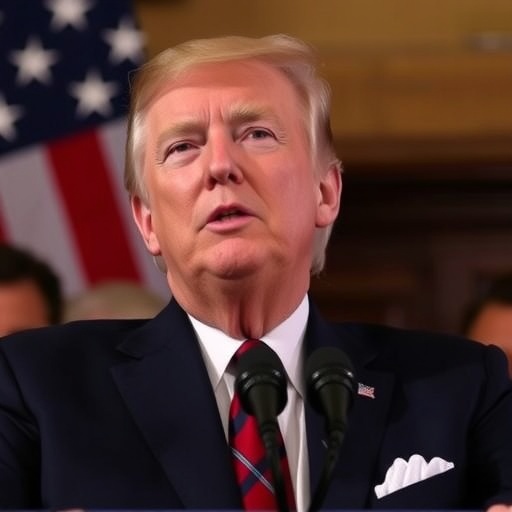Reagan’s Legacy Looms Over Trump Presidency as Comparisons Intensify in Conservative Circles
In a striking reminder of how history shapes the present, former President Ronald Reagan‘s towering influence continues to dominate discussions surrounding Donald Trump’s ongoing political saga. As Trump eyes a potential return to the White House in 2024, analysts and historians are drawing sharper parallels—and contrasts—between the two Republican icons, fueling debates on what defines true conservative leadership. A recent poll by the Pew Research Center reveals that 62% of Republicans view Reagan as the gold standard for the party’s future, placing Trump’s presidency under a microscope of historical comparison that could redefine the GOP’s trajectory.
- Echoes of Optimism: Reagan’s Charisma Mirrors Trump’s Rally Rhetoric
- Divergent Doctrines: Economic Policies Where Trump Veers from Reagan’s Blueprint
- Foreign Policy Flashpoints: From Cold War Triumphs to America’s First Stance
- Conservative Base Mobilization: How Reagan’s Coalition Evolves Under Trump
- Shaping Tomorrow’s GOP: Lessons from Reagan-Trump Parallels for 2024 and Beyond
Echoes of Optimism: Reagan’s Charisma Mirrors Trump’s Rally Rhetoric
Ronald Reagan, often dubbed the ‘Great Communicator,’ mastered the art of inspiring Americans through simple, uplifting messages that resonated across divides. His presidency from 1981 to 1989 was marked by a sunny disposition that turned economic gloom into the ‘Morning in America’ era. Fast-forward to Donald Trump’s tenure from 2017 to 2021, and similar threads emerge in how both leaders wielded charisma to rally their bases. Trump’s bombastic rally speeches, filled with promises of American greatness, echo Reagan’s ability to paint a vision of renewal amid crisis.
According to political historian Douglas Brinkley, author of Reagan’s Path to Victory, “Reagan and Trump both tapped into a sense of national frustration—Reagan with stagflation and the Cold War, Trump with globalization and cultural shifts. Their presidencies thrived on that emotional connection, making complex policies feel personal and urgent.” Data from the American National Election Studies supports this: Reagan’s approval ratings soared to 68% in 1984 after his economic recovery narrative took hold, while Trump’s peaked at 49% in early 2020, buoyed by pre-pandemic optimism.
Yet, the comparison isn’t without nuance. Reagan’s Hollywood-honed delivery was polished and folksy, often quoting philosophers and Bible verses to underscore conservative values. Trump, by contrast, favors unfiltered Twitter blasts—now X posts—that cut through media filters but sometimes veer into controversy. A 2023 study by the Brookings Institution notes that Trump’s social media strategy amplified his reach to 88 million followers, dwarfing Reagan’s era without digital tools, yet it also polarized audiences more intensely than Reagan’s broadcast addresses.
Conservative pundits like Sean Hannity have leaned into these parallels, stating on his Fox News show, “Trump is Reagan 2.0—bold, unapologetic, and putting America first.” This sentiment underscores how Reagan’s legacy serves as a benchmark for Trump’s presidency, with supporters arguing that both men revitalized a weary conservative movement.
Divergent Doctrines: Economic Policies Where Trump Veers from Reagan’s Blueprint
While stylistic similarities abound, the core of the Reagan-Trump historical comparison lies in their approaches to the economy, a cornerstone of conservative ideology. Reagan’s supply-side economics, dubbed ‘Reaganomics,’ slashed marginal tax rates from 70% to 28%, spurring GDP growth averaging 3.5% annually during his term. The result? Unemployment dropped from 10.8% in 1982 to 5.3% by 1989, cementing his reputation as the savior of American prosperity.
Trump’s presidency, entering amid recovery from the Great Recession, built on this foundation but introduced twists. His 2017 Tax Cuts and Jobs Act reduced the corporate rate to 21%, echoing Reagan’s tax reforms and boosting stock markets to record highs—the Dow Jones climbed 56% during his term. However, Trump’s trade wars, including tariffs on China totaling $380 billion in goods, marked a protectionist shift absent in Reagan’s free-market gospel. Reagan championed deregulation and open markets, signing the U.S.-Canada Free Trade Agreement precursor, while Trump withdrew from the Trans-Pacific Partnership and renegotiated NAFTA into USMCA.
Economists at the Heritage Foundation, a conservative think tank, highlight these divergences in a 2022 report: “Reagan’s vision was global conservatism; Trump’s was nationalist. Both delivered growth—U.S. GDP rose 2.5% annually under Trump pre-COVID—but Trump’s tariffs added $80 billion in costs to American consumers, per the Tax Foundation.” This split has ignited debates within conservative circles, with free-trade advocates like former Reagan advisor Pat Buchanan critiquing Trump’s approach as a departure from the Gipper’s legacy.
Quotes from key figures amplify the tension. Senate Minority Leader Mitch McConnell, a Reagan-era stalwart, remarked in a 2023 interview, “Reagan taught us that conservatism wins through innovation and alliances, not isolation.” Meanwhile, Trump allies like Larry Kudlow, who served as his economic advisor and previously lauded Reagan, defend the evolution: “In today’s world, Reagan’s principles adapt—Trump’s tariffs protected jobs Reagan’s policies assumed were safe.” These economic fault lines in the historical comparison reveal how Trump’s presidency both honors and challenges Reagan’s conservative orthodoxy.
Foreign Policy Flashpoints: From Cold War Triumphs to America’s First Stance
Reagan’s presidency is synonymous with ending the Cold War, his ‘evil empire’ rhetoric and Strategic Defense Initiative pressuring the Soviet Union into collapse. By 1989, the Berlin Wall fell, a victory that bolstered U.S. global standing and Reagan’s conservative credentials. Trump’s foreign policy, however, pivoted toward ‘America First,’ withdrawing from the Iran nuclear deal, Paris climate accord, and imposing sanctions on adversaries like North Korea—moves that isolated allies but appealed to his base.
Historical comparisons here are stark. Reagan built coalitions, as seen in his 1983 Grenada invasion, which enjoyed broad support and symbolized decisive action. Trump’s 2020 Soleimani strike in Iraq was similarly bold, eliminating a key Iranian general and drawing 52% approval in Gallup polls, yet it risked escalation without NATO backing. A 2021 Council on Foreign Relations analysis points out: “Reagan’s conservatism was ideological—defeating communism; Trump’s was transactional, prioritizing bilateral deals like the Abraham Accords, which normalized Israel-Arab ties without traditional alliances.”
Conservative internationalists, including former Secretary of State George Shultz who served under Reagan, have expressed reservations. In a posthumous reflection published in 2023, Shultz’s co-author noted, “Reagan’s legacy warns against unilateralism; Trump’s presidency tested that, sometimes to America’s detriment.” On the flip side, Trump supporters cite his no-new-wars record—unlike Reagan’s Lebanon barracks bombing that killed 241 U.S. service members—as a conservative win for restraint.
Statistics underscore the shift: U.S. defense spending rose 34% under Reagan (adjusted for inflation), focusing on deterrence, while Trump’s 2020 budget increased it by 7%, emphasizing border security and space forces. This foreign policy prism in the Reagan-Trump comparison highlights evolving conservative priorities, from global leadership to inward focus.
Conservative Base Mobilization: How Reagan’s Coalition Evolves Under Trump
Reagan’s 1980 landslide victory forged the modern conservative coalition—evangelicals, blue-collar workers, and fiscal hawks—securing 44 states. His presidency galvanized the Moral Majority, with voter turnout among white evangelicals jumping 15% from 1976. Trump’s 2016 win mirrored this mobilization, capturing 81% of white evangelicals and flipping Rust Belt states, but his style injected populism, railing against elites in ways Reagan critiqued more subtly.
Polling data from the Public Religion Research Institute shows enduring impact: 70% of Republicans in 2023 still cite Reagan as their ideal leader, yet Trump’s presidency shifted the party’s demographics, increasing non-college-educated voter share to 65%. Analysts like those at the Cato Institute argue in a recent paper, “Reagan’s conservatism was aspirational; Trump’s is grievance-driven, reshaping the GOP from within.”
Prominent voices fuel the discourse. Newt Gingrich, House Speaker under Reagan’s influence, told CNN, “Trump channels Reagan’s outsider energy but amplifies it with today’s media wars.” Conversely, Never Trump conservatives like Bill Kristol decry the comparison: “Reagan elevated debate; Trump’s presidency coarsened it, eroding conservative principles.” This internal tug-of-war illustrates how Reagan’s legacy benchmarks Trump’s ability to unite—or divide—the conservative movement.
Grassroots efforts reflect this evolution. The Reagan Library’s 2023 exhibit on presidential legacies drew 1.2 million visitors, many discussing Trump parallels, while Trump’s Save America PAC raised $100 million in 2022, funding events that invoke Reagan’s anti-government rhetoric against ‘deep state’ foes.
Shaping Tomorrow’s GOP: Lessons from Reagan-Trump Parallels for 2024 and Beyond
As the 2024 election looms, the intensified historical comparison between Reagan and Trump presidency promises to steer conservative strategy. With Trump leading GOP primaries by 50 points in recent Emerson polls, his camp leverages Reagan’s aura—campaign ads feature ‘Make America Great Again’ nods to ‘Morning in America.’ Yet, challengers like Ron DeSantis position themselves as Reagan purists, emphasizing policy over personality.
Experts foresee ripple effects. A 2023 RAND Corporation study predicts that if Trump secures the nomination, Reagan’s legacy could boost turnout among 75 million conservative voters nostalgic for 1980s triumphs, but alienate moderates if comparisons highlight divisiveness—Trump’s presidency ended with January 6 scrutiny, contrasting Reagan’s graceful exit. Forward-looking, historians like Jon Meacham suggest, “The Reagan-Trump synthesis might birth a new conservatism: populist yet principled, global yet guarded.”
Implications extend to policy arenas. On immigration, Reagan’s 1986 amnesty for 3 million undocumented workers clashes with Trump’s wall-building, prompting debates on compassionate conservatism. Climate and tech regulations could see Reagan’s deregulation ethos tested against Trump’s tariff innovations. Ultimately, this historical comparison isn’t mere nostalgia—it’s a roadmap for the GOP’s soul, determining if Trump’s presidency cements or complicates Reagan’s enduring conservative blueprint in an era of uncertainty.
In the coming months, as primaries unfold, watch for how these parallels influence donor dollars—Reagan-era PACs like the Club for Growth have donated $50 million to anti-Trump candidates—and voter sentiment. The shadow of the Gipper ensures that Trump’s path forward will be lit by Reagan’s light, for better or worse.










